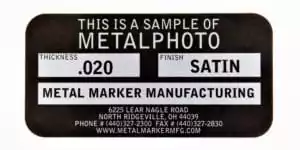In our modern cities and communities, we rely on access to utilities such as gas, electric, and water to ensure our homes are able to meet our basic everyday needs.
Energy organizations use meters to track the amount of usage each customer generates. This allows for accurate billing of only the energy which they accessed.
These devices are often marked with utility meter tags. These metal identification tags provide information to both servicers and customers.
Applications
Inspections
Meter readings and inspections are extremely important to utility companies. Ensuring their equipment is accurately tracking utility usage is vital for their business. If the meter is not functioning properly customers can be under or over-billed. This can lead to a loss of revenue, or unhappy customers.
Periodic inspections and readings of the meter also can detect any present issues with a service line. Third party safety inspections may help audit any issues that the service provider may have missed.
Sometimes referred to as utility badges, metal tags are used to help organize and streamline the inspection process.
Basic information such as company name or meter number is frequently added using a custom nameplate. This helps servicers to keep track of which meters they have already serviced, and indicate any repairs that need to be made.
In some cases, barcodes are added to the nameplates to provide a highly effective method for monitoring the asset. With a quick scan, data can be logged and updated to a tracking system.
Contact Info
Alongside servicing information, meters are commonly marked with contact information.
When there is an issue with utilities, customers want to get a fast response. If they don’t have the contact number handy, being able to check the meter for the number is a convenient alternative.
This can prove to be even more useful in the event of an emergency situation.
For example, if there is a potential gas leak, first responders may want to contact the gas company for assistance in shutting down the source. Providing a contact number directly on the meter provides a quick method to get support when necessary.
Marking Processes
Utility meters are exposed to the elements all year round. Any identification tag affixed to a meter must be ready to withstand the same level of abuse. Selecting a durable marking process helps ensure the tag will hold up to the same conditions.
Photo Anodization
When it comes to sheer versatility, it is hard to match the photo anodization process. Offering full customization alongside top notch durability, this is an all-around solid marking process.

Photo anodization embeds a design between layers of aluminum, providing an abrasion resistant image. Rated for 20+ years outdoors, the design will also withstand heavy weather conditions. As mentioned, this resiliency is crucial for meter marking.
Outside of durability, photo anodized tags are completely customizable. Logos, contact information, and any other information can all be incorporated. Many utility organizations use this process to add a bar code or QR code. This allows servicers to quickly scan the meter to track and log info.
In addition to custom designs, anodized aluminum nameplates can include a solid background color. This is utilized for color coding (i.e. blue for water meter, yellow for electric) or branding purposes.
Photo anodized tags are attached to meters using holes in the tag, or applied using an adhesive backing.
Embossing/Stamping
For a more simplified meter nameplate solution, embossing and stamping are two solid options. These processes directly press information into the metal substrate.
Embossing raises the design using a die set, while stamping recesses information. This permanent identification is incredibly sturdy, and will last for many decades in outdoor environments.

Unlike photo anodizing there are some limitations to the information which can be added to stamped or embossed nameplates. Custom logos are very limited, and require a custom stamp or die set to be made.
These processes excel best with basic letters and numbers. For example, embossed meter tags can be serialized to allow for easy asset tracking and inspection.
Embossed and stamped nameplates are typically attached to a meter using a wire, or directly mounted with hardware.
Plastic Tags
Some utility organizations utilize plastic tags to mark their meters. This can be pre-marked or blank for the operator to write information on. These ID tags are not nearly as durable as their metal counterparts, and will not survive for extended periods of time in outdoor environments.
In addition, sometimes these tags will be attached to a meter seal which will indicate the meter has been tampered with if it is removed.
Wrap-Up
Marking utility meters with metal identification tags is a simple but effective method for providing key information to servicers as well as customers.
The longevity of metal allows for the nameplates to hold up even when exposed to the outdoor conditions of energy meters.